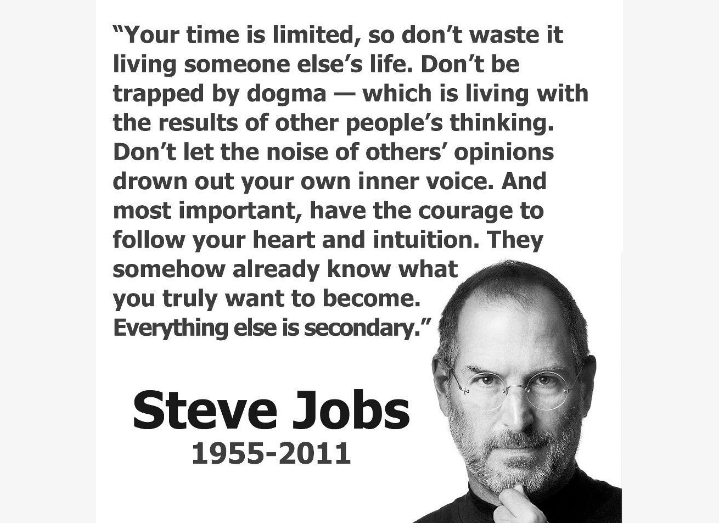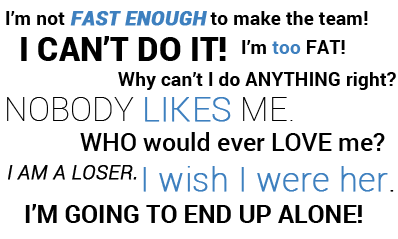leadership development
How To Set Goals | Quality #1: Make Your Goals Positive!
How To Set Goals
Quality #1: Make Your Goals Positive!
Ever seen one of those suspenseful scenes in a movie where the hero is climbing or hanging from a high place?
The hero’s sidekick watching the situation typically shouts, “Don’t look down!”
What happens? The hero looks down and gets freaked out from his fear of heights. To prevent the fear from taking over, the sidekick should have shouted, “Keep your eyes forward! You can do it! You’re almost there!”
Human beings tend to gravitate toward the direction in which we are focused. And, positivity is much more attractive than negativity. Leaders often emanate a positive energy that comes from knowing who they are, a focus on their vision, and the confidence they’re on the right path to success.
In that same manner…
Successful Goals ALWAYS State The POSITIVE — not the negative.
If you design your goal declaring a negative aspect, it becomes the object of your focus. This can be self-defeating.
Contrast these two examples:
Positive Goal: “I will earn a B or higher on my math final.”
Negative Goal: “I won’t fail my math test!”
– OR –
Positive Goal: “I will get along with my boss by showing respect at all times.”
Negative Goal: “I won’t let my boss get me mad, even if he acts like a jerk.”
When you frame your goal in a way, you will find yourself with a positive outlook and headed in the right direction to achieve the goal.
NEXT UP: How To Set Goals Quality #2: Make Your Goal Specific
Do you have any favorite goal-setting lessons, quotes, games, or activities that you use to teach goal-setting? Maybe you know a great tip to help eager goal-setters reach their goals faster? Leave your comments below!
I look forward to a great goal-setting discussion!
How to Set Goals: Your Goals Begin With You!
Over the last few weeks, I’ve been posting about How To Set Goals. I believe that goal-setting is one of the most important skills a leader can learn. So far we’ve outlined the 4 CRUCIAL QUALITIES OF AN EFFECTIVE GOAL. They are:
1. YOUR GOAL MUST BE POSITIVE
2. YOUR GOAL MUST BE SPECIFIC
3. YOUR GOAL MUST BE REACHABLE
4. YOUR GOAL MUST BE PERSONAL
However, before you begin our goal setting adventure, I want you to familiarize yourself with what I call, “The Law of Motivation”— A concept I came up with over 15 years ago when I developed my first programs on goal-setting for leaders. Who knew it would stick? I adapted it from that well-known 17th century scientist, Sir Issac Newton. Remember him? He’s the guy who discovered gravity when an apple fell on his head. Well, he also developed the groundbreaking First Law of Motion. It states that:
“An object at rest will remain at rest until acted upon by an outside force.”
This means that unless you live on a hill, a bowling ball sitting on your front lawn is not going to roll away by itself. Similarly, goals cannot be accomplished unless we put them into action.
Thus, we transform the Law of Motion into the Law of Motivation.
For our scenario, we will apply this scientific Law to Motivation and your life as a leader; the object will be defined as your goal—that tangible you want to have come true. It could be anything, depending on your stage of life or circumstances: the type of person you want to be, the grades you want to achieve, the friends you want to make, the job you want to land, the college you want to attend, the success of your next big project, the money you want to earn… because when you invent your future:
Defining your goal is as simple as that! Don’t know what your goal is yet? Examine your strengths and weaknesses. Consider your likes and dislikes. Reflect on your values. You’ll find it! This process requires time and deep thinking, so don’t gloss over it. When it comes to your goals, you must know and feel confident about what YOU want. So what does your goal have to do with motivation? Let’s take a hard look at what it means. The root of the word motivation is motive. Here’s how the dictionary defines motive:
“Motive: something causing or able to cause motion.”
Before you can motivate yourself, you must have a motive—something to get you going. If you have no object, or goal, you have nothing to put into motion.
So, to start, this Law of Motivation tells us:
“Your goals and dreams will remain at rest unless acted upon by an outside force.”
The second part of this law talks about an outside force. That’s where your motivation comes into play. You are that force.
Just as nobody can decide your goals for you, neither can somebody achieve them for you, nor can your goals fulfill themselves.
Although you may be surrounded by people who love you and want you to succeed in your life, they don’t care about your goals as much as you do. They can’t. They aren’t you. Most people are busy enough as it is trying to get their own goals into motion to give yours the attention that it needs—and that it deserves. Nobody can get your object into motion except you. That’s why the Law of Motivation ultimately says:
“Your goal is not going anywhere until you take responsibility and move it yourself!”
Sounds simple, doesn’t it? Well, it is! The basics of goal-setting have been around for generations. It’s one of the tenets of leadership. However, studies show that still less than three percent of people use goal-setting skills where, and when, it really counts.
So many people walk through their world, subconsciously thinking, “I hope I end up somewhere good.” But they do not intentionally make a plan to get to that “good” place. Many years later they look back and wonder why their hopes and dreams are not actualized. This should come as no surprise.
How can you end up somewhere good if you have no idea where (or what) good is?

That’s what goal setting is all about – not letting life and chance decide where you end up; instead purposefully transform hopes and dreams into achievable goals.
Remember the three percent of individuals who do set goals? Among them you’ll find the top achievers and leaders of this world. It wasn’t magic or happenstance. They harnessed their internal motivation and focused their efforts for proper goal setting.
This is the Law of Motivation in action. Like other scientific laws, this process does not only work in a few random instances. It can be replicated by anyone who desires their dreams to come true and sets out to achieve their goals.
Next: Your Inner Critic: 4 Words That Sabotage Goals
Do you have and tips or tricks on how to reinforce your goals and stay motivated to stay on the path to achieving your goal? Please share your ideas with us in the comments section below!
Goal Setting Basics: 4 Words That Sabotage Goals
The Inner Critic is a concept that psychologists use to refer to that inner voice that attacks a person, saying that he or she is bad, wrong, stupid, worthless, and so on. And it loves to show up right when you’re trying to accomplish your most important goals. It tells you that you are going to fail. And oftentimes it succeeds – simply because you choose to believe those negative thoughts.
The voice of this Inner Critic is nothing more than a thought. And the average person has about 50 thoughts per minute! These ideas or opinions are produced by thinking or just suddenly occurring in our mind. They can be about anything… from a memory of our last vacation, a joke we heard on TV, a doubt about our life, or even a fierce dragon! Your Inner Critic LOVES to hold on to certain negative thoughts, and accepts them as true – even when there’s not one shred of proof to back it up – that’s when these thoughts transform into beliefs.
Remember: Just since we believe something, it doesn’t make it true. Heck, people used to believe the Earth was the center of the universe until scholars took a good look and proved them wrong.
When setting goals, a good place to silence the Inner Critic is with our words.
Ever tell a lie? Of course you have. Ever tell a lie so many times that one day you caught yourself thinking that the lie was the truth. That’s because the words we speak reinforce your beliefs.
When we say our negative thoughts out loud, we reinforce those beliefs which keep us from taking action and eventually lead us to failure.
However, when we transform those thoughts into positive statements, we force our Inner Critic to listen and change the things it tells us.
Here are 4 Negative Words we can avoid when speaking about our goals and the 4 Positive Words we should use to replace them:
#1 – “TRY”
TRY is one of the most useless words ever. It’s the word we use when we intend to fail.
What did our old pal YODA say about the word try? That’s right!
“DO or DO NOT – There is no try.”
#2 – “CAN’T”
CAN’T is such a final word. It instantly tells your Inner Critic that all possibility of success is gone.
Which is just so sad! Especially, since most of the time when someone says CAN’T – they usually mean WON’T.
If you wan’t to set forth on a positive track, substitute the word CAN’T with CAN!
#3 – “WHY”
Your Inner Critic is always looking for an excuse to butt-in and give an opinion.
It likes nothing better than to tell you you’re not good enough and seeks to talk you out of your goals.
When you say the word: “WHY” – you’re giving your Inner Critic a direct invitation to jump in and fill in the blanks for you.
When we feel desperate or helpless it often comes out as “WHY ME?”
When doubt enters your mind, replace WHY with HOW.
When you ask: “WHY CAN’T I FIND A JOB?” – Your Inner Critic comes up with all sorts of negative answers that psyche you out!
Instead ask: “HOW AM I GOING TO DO THINGS DIFFERENT TO FIND THE CAREER THAT’S WAITING FOR ME?”
And instead of asking: “WHY AM I DOING SO BAD IN SCHOOL?”
Assign your creativity to work on: “HOW AM I GOING TO ARRANGE MY SCHEDULE TO ALLOW ME TO STUDY MORE?”
See how it forces your Inner Critic to use its efforts more efficiently? You challenge it to come up with a solution to your goal rather than knock it down.
#4 – “DON’T”
Human beings tend to gravitate toward the direction in which we are focused. When we get wrapped up in thinking and talking about the things we don’t want to have happen in our lives, we take away our focus from the things we do want.
It’s the first quality any goal needs to succeed. I talk about it in a past post: How To Set Goals | Quality #1: Make Your Goals Positive!
Focus your goals on the positive with words like: I WILL or I WANT or I AM!
ONE LAST THOUGHT ON NEGATIVE SELF-TALK & CONQUERING THE INNER CRITIC:
There are so many ways that our Inner Critic can make us struggle with the person we were born to be. Check out this video created by ALWAYS.
They have launched a campaign to help young women eliminate negative words from their lives.
When I watched it, it made me re-think everything that comes out of my mouth. Let me know what you think.
Has your Inner Critic ever kept you from getting what you want? Do you have any tips on how to keep positive when self doubt starts to interfere with your goals. We want to know! Please share your ideas with us in the comments section below.
A Guide to Goal Setting
Be it professional, academic, or personal, effective goal setting is easier said than done. Your goals can only turn into reality, if they were set correctly in the first place. Before you embark on setting your life goals, read through this guide to ensure you’re your goals are set in the right direction.
Determine what your goals should be.
Do this by allowing some time for contemplation, and thinking what is important to you. Brainstorm and list down all the things and targets you would want to achieve and eventually shortlist the most important ones.
Set your goals to be high in quality, not quantity.
Having a list of 20+ goals may not only be overwhelming to look at, but holds a higher chance to demotivate and slack you. To ensure accomplishing them, focus on the most important of your goals, which should ideally be 5-7 in number and be concise enough to be stored in your memory.
Make sure your goal setting is S.M.A.R.T.
That being said, S.M.A.R.T. goals refer to goals that are:
Specific:
To make your goals turn into reality, you need to identify what you exactly need to accomplish and set a course of action accordingly. Be as specific and unambiguous as you can when setting your goals, for example, ‘travel and explore’ may be too wide and vague a goal, but narrowing it down to ‘Travel and explore the historical cities of Europe’ may add some direction and precision to it.
Measurable:
Having a measurable goal is necessary to be able to track your progress and decide on future strategies to move towards it. If you wish to buy your own apartment worth $20,000, a measurable goal would be to save $5000 each year for four years and break it down into monthly savings to enable you to plan your expenses and keep an account of your savings.
Achievable:
Let your goals start with an action verb to make them attainable. Instead of formulating a goal to ‘be more consistent in Math grades’, make it more achievable by rephrasing it as ‘Solve two sample papers each week to obtain better grades in Math’
Realistic:
While an ambitious goal setting should call for getting out of your comfort zone and aiming high, one has to ensure that the goals are sensible and practical. Aiming to reach the top ten employees in your first month at work may prove to be too imaginative, work towards improving your productivity and getting a name under notable achievements for the month instead.
Time-constrained:
While “I will lose 20 pounds” maybe achievable and measurable, it does not provide a time limit to achieve. Planning to lose 20 pounds in four months makes the goal time bound and dividable into smaller monthly goals, hence making it more specific and reachable.
Write them down and review them frequently.
Once you have your goals written down, you have half the action plan to achieve them. Writing your goals down reassures you of your intention to make them happen and sets things in motion. A written goal also serves as an effective reminder and progress tracker. Review your goals regularly and evaluate your current progress towards achieving it, and determine your next steps to move towards them. It depends on your individual preference to review them daily, weekly or monthly, but make sure to keep yourself inspired, motivated and well-reminded of your objectives.
Avoid going public with your goals.
Remember they are your goals and should remain personal to you. No one else can associate the same feelings of enthusiasm, dedication and commitment to your goals. Unless you think that sharing them with a certain person, an expert, mentor, business partner or group leader, for example, may help you achieve your goals, avoid sharing them with others as it may make them less likely to materialize.
How To Set Goals | Goal Setting Fundamentals
“A leader is one who knows the way, goes the way, and shows the way.”
— John C. Maxwell
⇒ Leaders Set Goals
Do you consider yourself a leader?
Sometimes we associate leaders with high-profile, powerful positions.
• The CEO of a Company.
• The Principal of a School.
• The President of the United States
And yes, these people are leaders. But you don’t have to be rich, famous, or powerful to be a leader. You just need to be a person who leads.
Leaders are needed in all areas of life — in families, amongst friends, on teams, in the workplace, and on campus.
They’re the ones that open doors for others to follow and set the standards by which we live.
Leaders can possess a variety of different characteristics and personality traits. They might be driven, intelligent, creative, hard-working, charismatic, or even domineering. But the similarity that one can find amongst almost every leader… THEY HAVE GOALS!
“You can practice shooting eight hours a day, but if your technique is wrong, then all you become is very good at shooting the wrong way. Get the fundamentals down and the level of everything you do will rise.”
—Michael Jordan
⇒ Fundamentals of Effective Goal Setting
In goal setting, technique is everything!
When I hear people explain that they are having trouble with accomplishing their goals, it is usually because they started off wrong from the beginning. They had bad goals. I don’t mean the things they wanted were bad. It’s just that they didn’t set their goals up for success.
A goal is more likely to be accomplished if it’s designed with these qualities in mind:
1. YOUR GOAL MUST BE POSITIVE
2. YOUR GOAL MUST BE SPECIFIC
3. YOUR GOAL MUST BE REACHABLE
4. YOUR GOAL MUST BE PERSONAL
If your goal doesn’t satisfy these four requirements, you might run into some trouble along the way. Over the next few posts, we’ll take a closer look at these characteristics that differentiate a good goal from a bad goal.
NEXT UP: How To Set Goals Quality #1: Make Your Goal Positive
Do you have any favorite goal-setting lessons, quotes, games, or activities that you use to teach goal-setting? Maybe you know a great tip to help eager goal-setters reach their goals faster? Leave your comments below!
I look forward to a great goal-setting discussion!














